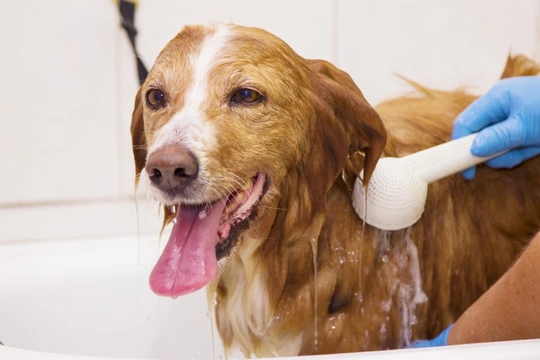
Do frequent baths help to ease allergies in dogs?
Suffering from an allergy might seem like a minor problem in the greater scheme of things, but anyone who suffers from a chronic allergy or even a transient, seasonal problem like hay fever will be all too aware that allergies can make you quite miserable, particularly if they remain symptomatic for a protracted period of time.
Dogs can of course suffer from allergies just as people can, and these can be challenging to identify and treat effectively as there are so many potential allergenic triggers, and getting to the bottom of what is causing a problem for your dog can be very difficult. How any given allergy affects any given dog can be highly variable too; some will suffer only very mildly, whilst the reactions in other dogs can be quite acute.
If your dog suffers from allergies that also affect their quality of life, you’re probably working hard to help to support your dog, control their symptoms, and minimise exposure to allergenic triggers.
There are a whole host of different ways in which you can help you dog with allergies, and your vet will in their turn help you to determine the best approach. This will of course depend on the type of symptoms your dog displays and what they are allergic to, but there are generally a range of options for every dog that may be used alone, or in combination with other approaches.
If your dog suffers from allergies that manifest on their skin and coat, your vet will likely have advised you about bathing your dog to help to reduce allergens and sooth the skin, promoting good health of the skin and coat.
If this is the case, you may be wondering if bathing your dog more frequently will help to reduce the effects that their allergy has on them, and in some cases, you may be right – but not always.
In this article we will look at whether or not bathing your dog more often can help to ease their allergies. Read on to learn more.
What type of allergies can bathing your dog help with?
Virtually any substance you think of can be a potential allergenic trigger, and the key to effectively treating or managing an allergy of any type is to identify what is causing it in the first place.
Contact dermatitis is a type of allergy that affects dogs when a certain trigger comes into contact with the skin, and some dogs that are sensitive to airborne triggers like pollens that cause respiratory symptoms might also result in skin symptoms too.
Even food allergies can make your dog’s skin sore and irritated, but in this case, this particular set of symptoms might present on the skin, but they are not caused by direct contact with it.
If your dog’s allergies occur due to contact with the skin from an allergenic trigger (as is the case with contact dermatitis) or due to something in the environment like pollen that can also cling to the coat, bathing can help to remove traces of the allergenic trigger and so, lessen its impact.
Even if the allergy is not caused by something coming into contact with the skin and coat, if your dog’s allergy results in sore or irritated skin, the right type of bathing can help to ease this and make your dog more comfortable.
Does more frequent bathing help to reduce allergies?
Dogs as a rule tend to need a bath every few weeks, to keep them clean and smelling fresh and prevent dirt and muck building up in the coat and making their skin dirty and grimy. Bathing dogs too often can result in their skin becoming dry and irritated as the coat is stripped of its natural oils, and so dogs should not generally be bathed too often, but only when they actually need it.
However, in some cases, bathing more often (every couple of weeks, or even potentially more frequently if advised by your vet) can help with allergies. This is because bathing removes allergens from the skin and coat so that they cannot irritate your dog further, and using the right type of soothing, nourishing shampoos and topical creams (if relevant) can help to ease the allergy’s symptoms too.
That said, bathing a dog with allergies very frequently is not always the right move. If your dog doesn’t suffer from skin or coat problems as a result of their allergy, frequent bathing will only make a difference if your dog’s coat is picking up traces of the allergen that are then causing symptoms in other areas.
Even if your dog’s allergy affects their skin and coat directly, if you bathe them too often or use products that are too harsh, this may result in further irritation and dryness of the skin, rather than helping to soothe it.
Ask your vet about the optimum frequency to bathe your dog with allergies, and the right types of products to use to do so.
Other ways to help a dog with skin allergies
You don’t have to give your dog a bath to help to reduce allergens on the skin and coat – when you come back from a walk (where your dog may have come into contact with or been exposed to allergens) just wiping your dog’s fur over with a clean, damp cloth can help to remove allergens and so, limit their effect.
Antihistamines, medications, removal of allergenic triggers and exposure therapy are all things to think about too, and your vet will be able to advise you on the type of approach that is the best fit for your own dog and their situation.



